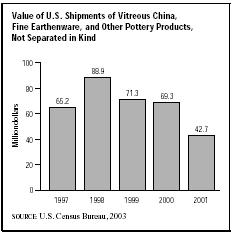SIC 3263
FINE EARTHENWARE (WHITEWARE) TABLE AND KITCHEN ARTICLES
This industry consists of companies manufacturing semivitreous earthenware table and kitchen articles. These include fine semivitreous whiteware, semivitreous earthenware used for cooking and serving food, and both commercial and household earthenware. Manufacturers of vitreous china table and kitchen articles are included in SIC 3262: Vitreous China Table and Kitchen Articles.
NAICS Code(s)
327112 (Vitreous China, Fine Earthenware and Other Pottery Product Manufacturing)
Fine earthenware table and kitchen articles have been made for centuries. Earthenware is porous, coarse, and opaque—unlike vitrified porcelain and bone china, which are nonporous and translucent. All are considered pottery and begin with clay and other raw materials, but earthenware is fired at lower temperatures and is more breakable.
Many styles and types of earthenware have become popular as everyday dinnerware. Since earthenware was less expensive than bone china or other vitreous tableware, sales of it were less affected by economic downturns. China and porcelain products have begun to draw more consumers, however, especially from high-income households headed by 45- to 54-year-olds. The bridal market also accounted for a large percentage of retail sales of semivitreous earthenware.

The oldest form of pottery, earthenware, was made in China as early as the ninth century, where it was dried in the sun. Kilns became the source of heat to fire pottery that becomes modern dinnerware, but in the industry as a whole, much of the technology is the same as it was centuries ago. Not much has changed—including the labor intensive nature of the work and the skilled craftsmen who are employed to manufacture products with high standards of quality—but pottery wheels are electric, and a jiggerblade can speedily shape a plate.
In the early 1990s, manufacturers were beginning to respond to consumer concerns about lead content in chinaware. Some manufacturers changed the recipes of their glazes to reduce the lead content. Ceramic goods imported from other countries were more often to blame since many countries did not have strict lead content rules. California's Proposition 65, the Safe Drinking Water and Toxic Enforcement Act of 1986, required labeling on chinaware, warning consumers if a product exposed them to more than 0.5 micrograms of lead per day.
Although most of the same companies that manufactured earthenware also manufactured vitreous china, far fewer people worked directly on these products. In 2000, approximately 18,696 people were employed in both industries, of which only a few hundred worked in the earthenware industry, and this number was expected to continue to decrease.
The value of industry shipments in 2001 was $42.7 million, less than half the value of shipments in 1997, which totaled $88.9 million. This segment of the industry accounted for only 4 percent of total shipments of vitreous china, fine earthenware and other pottery products in 2001. Its decline was due in part to the economic downturn in the United States and to a growing number of inexpensive imports. Imports accounted for more than 50 percent of the sales in earthenware and kitchenware. Most foreign competition came especially from Japan, Taiwan, China, and England.
Industry jobs included machine operators in the sliphouse; mold runners, casters, and jiggermen who work to shape and form the clay; cutters and finishers who dry and again shape the product; glaze grinders and decorators; kiln firemen and loaders; inspectors, selectors, and stampers; and packers. The only occupations expecting growth through the year 2005 were painting, coating, and decorating workers. Extruding and forming machine workers were expected to have the most dramatic decrease—80.6 percent.
Average hourly wages for production workers in this industry were $11.20 in 2000. Kiln operators earned hourly wages of $6.06 to $9.26, while molders and casters earned hourly wages of $4.61 to $9.86.
The industry leaders in the 1999 were Zrike Company of Oakland, New Jersey, with sales of $14 million, and Rancho Cucamonga, California-based Bradshaw International Inc., which had acquired Bonny Products Inc., of Washington, North Carolina, in late 1999. In 2003, Bradshaw launched a plant renovation that would double its capacity.
Further Reading
U.S. Census Bureau. "Statistics for Industry Groups and Industries: 2000." February 2002. Available from http://www.census.gov/prod/2002pubs/m00as-1.pdf .
——. "Value of Shipment for Product Classes: 2001 and Earlier Years." December 2002. Available from http://www.census.gov/prod/2003pubs/m01as-2.pdf .
Comment about this article, ask questions, or add new information about this topic: